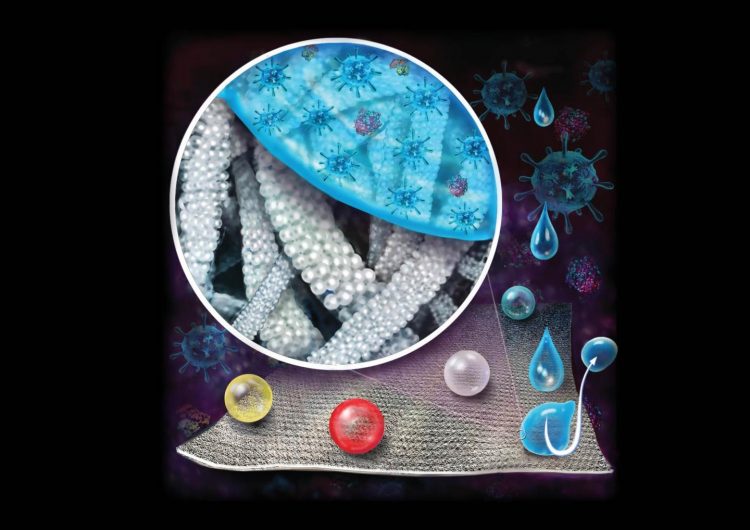Pitt researchers create durable, washable textile coating that can repel viruses

An illustration shows the treated textile's ability to repel fluids. Credit: University of Pittsburgh
Masks, gowns, and other personal protective equipment (PPE) are essential for protecting healthcare workers. However, the textiles and materials used in such items can absorb and carry viruses and bacteria, inadvertently spreading the disease the wearer sought to contain.
When the coronavirus spread amongst healthcare professionals and left PPE in short supply, finding a way to provide better protection while allowing for the safe reuse of these items became paramount.
Research from the LAMP Lab at the University of Pittsburgh Swanson School of Engineering may have a solution. The lab has created a textile coating that can not only repel liquids like blood and saliva but can also prevent viruses from adhering to the surface. The work was recently published in the journal ACS Applied Materials and Interfaces.
“Recently there's been focus on blood-repellent surfaces, and we were interested in achieving this with mechanical durability,” said Anthony Galante, PhD student in industrial engineering at Pitt and lead author of the paper. “We want to push the boundary on what is possible with these types of surfaces, and especially given the current pandemic, we knew it'd be important to test against viruses.”
What makes the coating unique is its ability to withstand ultrasonic washing, scrubbing and scraping. With other similar coatings currently in use, washing or rubbing the surface of the textile will reduce or eliminate its repellent abilities.
“The durability is very important because there are other surface treatments out there, but they're limited to disposable textiles. You can only use a gown or mask once before disposing of it,” said Paul Leu, co-author and associate professor of industrial engineering, who leads the LAMP Lab. “Given the PPE shortage, there is a need for coatings that can be applied to reusable medical textiles that can be properly washed and sanitized.”
Galante put the new coating to the test, running it through tens of ultrasonic washes, applying thousands of rotations with a scrubbing pad (not unlike what might be used to scour pots and pans), and even scraping it with a sharp razor blade. After each test, the coating remained just as effective.
The researchers worked with the Charles T. Campbell Microbiology Laboratory's Research Director Eric Romanowski and Director of Basic Research Robert Shanks, in the Department of Ophthalmology at Pitt, to test the coating against a strain of adenovirus.
“As this fabric was already shown to repel blood, protein and bacteria, the logical next step was to determine whether it repels viruses. We chose human adenovirus types 4 and 7, as these are causes of acute respiratory disease as well as conjunctivitis (pink eye),” said Romanowski. “It was hoped that the fabric would repel these viruses similar to how it repels proteins, which these viruses essentially are: proteins with nucleic acid inside. As it turned out, the adenoviruses were repelled in a similar way as proteins.”
The coating may have broad applications in healthcare: everything from hospital gowns to waiting room chairs could benefit from the ability to repel viruses, particularly ones as easily spread as adenoviruses.
“Adenovirus can be inadvertently picked up in hospital waiting rooms and from contaminated surfaces in general. It is rapidly spread in schools and homes and has an enormous impact on quality of life–keeping kids out of school and parents out of work,” said Shanks. “This coating on waiting room furniture, for example, could be a major step towards reducing this problem.”
The next step for the researchers will be to test the effectiveness against betacoronaviruses, like the one that causes COVID-19.
“If the treated fabric would repel betacornonaviruses, and in particular SARS-CoV-2, this could have a huge impact for healthcare workers and even the general public if PPE, scrubs, or even clothing could be made from protein, blood-, bacteria-, and virus-repelling fabrics,” said Romanowski.
At the moment, the coating is applied using drop casting, a method that saturates the material with a solution from a syringe and applies a heat treatment to increase stability. But the researchers believe the process can use a spraying or dipping method to accommodate larger pieces of material, like gowns, and can eventually be scaled up for production.
###
The paper, “Superhemophobic and Antivirofouling Coating for Mechanically Durable and Wash-Stable Medical Textiles” (DOI: 10.1021/acsami.9b23058), was co-authored by Anthony Galante, Sajad Haghanifar, Eric Romanowski, Robert Shanks and Paul Leu.
Media Contact
All latest news from the category: Materials Sciences
Materials management deals with the research, development, manufacturing and processing of raw and industrial materials. Key aspects here are biological and medical issues, which play an increasingly important role in this field.
innovations-report offers in-depth articles related to the development and application of materials and the structure and properties of new materials.
Newest articles

Properties of new materials for microchips
… can now be measured well. Reseachers of Delft University of Technology demonstrated measuring performance properties of ultrathin silicon membranes. Making ever smaller and more powerful chips requires new ultrathin…

Floating solar’s potential
… to support sustainable development by addressing climate, water, and energy goals holistically. A new study published this week in Nature Energy raises the potential for floating solar photovoltaics (FPV)…

Skyrmions move at record speeds
… a step towards the computing of the future. An international research team led by scientists from the CNRS1 has discovered that the magnetic nanobubbles2 known as skyrmions can be…





















